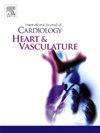Sex-related differences in the prognostic utility of inflammatory and thrombotic cardiovascular risk markers in patients with chest pain of suspected coronary origin
IF 2.5
Q2 CARDIAC & CARDIOVASCULAR SYSTEMS
引用次数: 0
Abstract
Background
α1-antichymotrypsin (SERPINA3), high sensitivity C-reactive protein (hsCRP) and pentraxin 3 (PTX3) are acute phase proteins triggered by inflammation, whereas D-dimer, fibrin monomer and α2-antiplasmin are thrombo-fibrinolytic markers. Sex differences in relation to cardiovascular disease were investigated.
Methods
A total of 871 consecutive patients (61.0 % males; females: 77.3 years, males 69.1 years) were included. Of these, 380 were diagnosed with an acute myocardial infarction (MI). Stepwise Cox regression models, applying normalized continuous loge/SD values, were fitted for the biomarkers with all-cause mortality, MI and stroke, respectively, and a composite endpoint within 7 years as the dependent variables.
Results
Except for α2-antiplasmin, all biomarkers were significantly associated with all-cause mortality and the combined endpoint in the univariate analysis. None of the inflammatory biomarkers predicted all-cause mortality in females after multivariable adjustment but were significant predictors in males (SERPINA3: HR 1.34 (95 %CI 1.16–1.56), p < 0.0001. hsCRP: HR 1.19 (95 %CI 1.02–1.38), p = 0.027. PTX3: HR 1.22 [95 %CI 1.04–1.44], p = 0.018. The p-value for interaction suggests a sex difference in the prognostic weighting of SERPINA3 (p = 0.015). None of the thrombo-fibrinolytic biomarkers predicted all-cause mortality in males after adjustment, but D-dimer and fibrin monomer were significant predictors of all-cause mortality in females (HR 1.51 [1.29–1.78], p < 0.0001, and HR 1.28 [1.08–1.53] p = 0.005, respectively). A trend towards interaction for D-dimer (p = 0.07) may suggest a sex difference in its prognostic weighting.
Conclusion
SERPINA3, hsCRP and PTX3 predicted long-term all-cause mortality in males but not in females. The opposite relationship was observed for D-dimer and fibrin monomer.
求助全文
约1分钟内获得全文
求助全文
来源期刊

IJC Heart and Vasculature
Medicine-Cardiology and Cardiovascular Medicine
CiteScore
4.90
自引率
10.30%
发文量
216
审稿时长
56 days
期刊介绍:
IJC Heart & Vasculature is an online-only, open-access journal dedicated to publishing original articles and reviews (also Editorials and Letters to the Editor) which report on structural and functional cardiovascular pathology, with an emphasis on imaging and disease pathophysiology. Articles must be authentic, educational, clinically relevant, and original in their content and scientific approach. IJC Heart & Vasculature requires the highest standards of scientific integrity in order to promote reliable, reproducible and verifiable research findings. All authors are advised to consult the Principles of Ethical Publishing in the International Journal of Cardiology before submitting a manuscript. Submission of a manuscript to this journal gives the publisher the right to publish that paper if it is accepted. Manuscripts may be edited to improve clarity and expression.
 求助内容:
求助内容: 应助结果提醒方式:
应助结果提醒方式:


